SKYSCRAPER. About the contribution of Americans to the treasury of world achievements
15 October 1880, the German Emperor Wilhelm I, solemnly opened the newly rebuilt Cologne Cathedral. With a height of 157,4 meters, he became not only the highest Catholic cathedral, but also the highest building in the world. In the speeches about his discovery, it was asserted that this priority was achieved for many centuries. They cited the fact that it took more than four thousand years to erect a building that exceeds the pyramid of Cheops by almost 20 meters. And the emperor believed them. As it soon turned out, completely in vain.
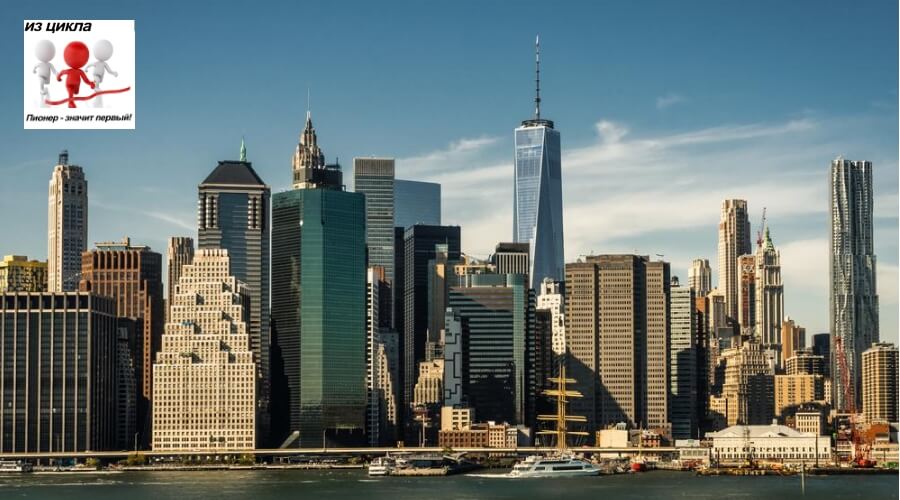
Фото: Depositphotos
Just ten years later, due to many years of rivalry between Christian communities, a Lutheran church was erected in the German city of Ulm, which, at a height of 161,5 meters, still remains the tallest church in the world. So they divided their spheres of influence: Cologne Cathedral became the tallest two-headed (with 2 towers) cathedral in the world, and Ulm Cathedral became the tallest single-headed one. With this, everyone calmed down, and Germany could afford to rest on its laurels.
HOW IT BEGAN
It should be noted that attempts to rise as high as possible to the sky have been known since biblical times - starting with the construction of the Tower of Babel. With the development of cities, and the tightness of buildings in a limited urban space surrounded by fortress walls, there is a growing need to build ever taller structures. And soon the fortifications themselves began to be used for urban needs (as in ancient Bologna). Gradually, many cities around the world were decorated with soaring cathedral spiers and multi-story buildings. With the acquisition of more and more freedoms and rights by the cities themselves, the buildings of their city halls become more and more beautiful and prestigious. They also grew upward, acquiring an increasingly significant position in urban development over time.
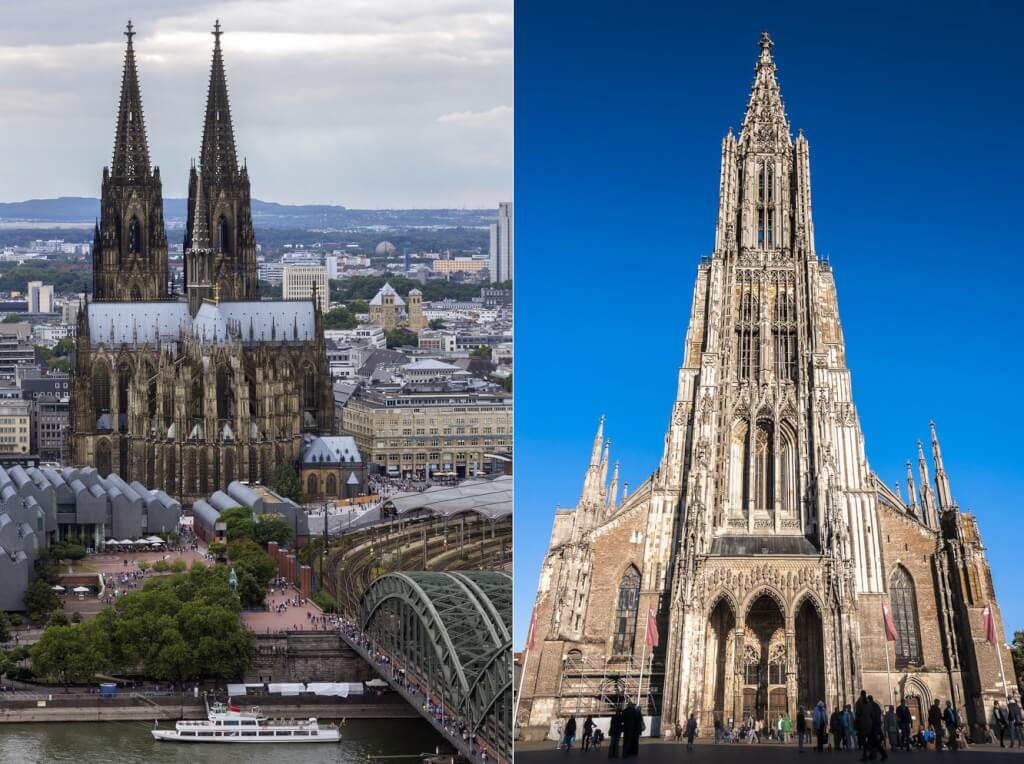
Kölner Dom and Ulmer Münster (Cologne and Ulm cathedrals). Photo: Vector, ForumDaily collage
And so, in the early 1880s, when the talented architect John McArthur, Jr. receives an order to build a new city hall in Philadelphia - Philadelphia City Hall, he is eager to break the Ulm record and erect the tallest building in the world. Made of brick, followed by facade finishing with limestone, granite and marble. Using the most fashionable style of those times - the lush empire style. With peaked roofs, attics, colonnade, statues and corresponding ornaments. And at the top of the tower, MacArthur Jr. installed an eleven-meter statue of the city’s founder, William Penn. At the same time, the total height of the building was 167 meters, and thereby exceeded the height of the cathedral in Ulm by 5,5 meters.
On the subject: Statue of Liberty: the history of the American symbol
City architect Edmund Bacon will later utter a historic phrase that no gentleman should now build buildings above the "William Penn hat visor." He was as naive as the architects of Emperor Wilhelm I. Looking from the height of today, it is clearly seen that Bacon thought too well about the gentlemen of Pennsylvania, not to mention the gentlemen of the United States. (Manhattan Municipal Building will be erected already in 1914 in New York, using a metal frame, 177 meters in height) But if this wish is extended to the construction of the main city municipal structures, then today Philadelphia City Hall continues to be the tallest brick city hall of the world. Its construction was carried out from 1894 to 1903 year. And actually drew a line under the construction of high-rise buildings made of brick.
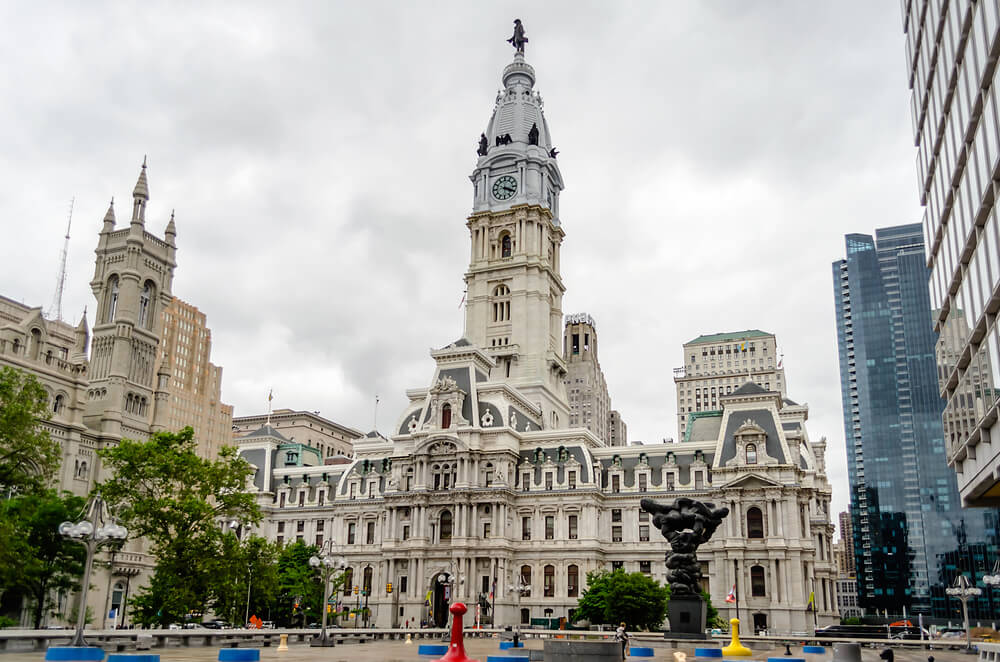
Philadelphia City Hall. Photo: Depositphotos
BRAND'S BIRTH
Meanwhile, in far Chicago, completely different events were already happening. In 1871, most of the city burned down during the Great Chicago fire. In this case, about 18000 buildings suffered. But, paradoxically, it sounds, but it was this fire that gave the opportunity to rebuild the city, and served as the impetus for the greatest construction boom in the United States. And he, in turn, led to the formation of the famous Chicago school of architecture and a new direction in architecture - the construction of skyscrapers. Rapid construction was accompanied by a sharp increase in the population of the city. By 1890-th it doubled and amounted to more than a million. And the massive migration of African Americans from the South to the North to 1893 brought 1,125 million more to the city. Land in the central part of the city became more and more expensive, and the cost of 1 square. m housing was previously 130 $, 1890 year rose to 900 $.
This has forced developers to think about dramatically increasing the height of buildings. But serious technical problems awaited them here. The main one is what material to use as load-bearing structures of residential buildings? After all, increasing the height of brick buildings meant thickening the walls, which had to withstand the weight of the structure. In the same Philadelphia City Hall they reached 6,70 meters, and in the Chicago 16-story brick Monadnock Building - 1,80 meters, which made it economically unprofitable to use brick as a load-bearing element in multi-story construction. Not to mention the fact that, according to the recommendations, it was already becoming difficult for residents to climb the stairs on foot to the sixth or seventh floors. Hence the construction of so-called “five-story buildings” that do not require elevator equipment is so widespread in the cities of the former Soviet Union. Added to this were reports that it was necessary to resolve issues related to the water supply of buildings, since the pumps operating at that time could not transport water to high altitudes.
These problems seemed completely insurmountable when William Le Baron Jenney was commissioned to build the First Leiter Building in 1879. By that time, he was already a fairly experienced engineer, having studied at Harvard and the École Centrale Paris. At the same time, he had already served as an engineer officer in the army, and for several years he taught architecture at the University of Michigan. Since 1867, Jenny already had her own architectural office in Chicago. Analyzing the problems that beset him, he soon realized that the water supply of high-rise buildings could be solved using a system of intermediate reservoirs. The situation with elevators turned out to be more complicated, although the first attempts to lift with their help were made by Archimedes, during the times of the Roman Empire. But the main problem hindering their use was the frequent breaks of the cables holding them. There were attempts to use “screw” elevators, but they did not lead to success. And finally, in 1854, the American inventor Otis (Elisha Graves Otis) demonstrated his new invention at an exhibition in New York - an elevator safety device. Standing on the open platform of the lift, he cut off the rope holding it with an ax. However, thanks to the “catchers” he invented, he did not fall, but remained in place. And already in 1861, the same Otis patented an electric passenger elevator.
Over time, the rapid development of this industry has become a decisive factor in the development of high-rise construction. So, much later, the 104 elevator will be installed in the second highest US skyscraper (Willis Tower in Chicago), 16 of which are provided for two floors, that is, capable of receiving and disembarking passengers from two floors at once. All the achievements that were patented before the start of construction were subsequently used in full by William Le Baron Jenny. It remained to be determined only with the main material for the construction of supporting structures. Now we would surely say: reinforced concrete should have been applied. Forgetting that the French gardener Joseph Monier (Joseph Monier) had already been looking for methods since 1861, how to make garden garden pots more durable: clay products were fragile, short-lived from wood, and cracked from concrete. Then he wrapped the concrete tub with wire, and so that it did not rust - smeared it with cement mortar on top. Tub has turned out amazing strength, and already in 1867, he received his first patent for a product of reinforced concrete. However, until his full recognition will be held for many more years.
On the subject: The White House: The History of the American Symbol
Naturally, in Chicago they knew nothing about it. Although they were well aware that the construction of railways led to a significant increase in metal production in the country. And therefore, more and more often architects began to have ideas about using it in the construction industry. Everyone was familiar with the use of metal structures during the construction of the Brooklyn Bridge (then also called New York and Brooklyn Bridge). In New York, James Bogardus, who used cast-iron elements and columns in his buildings, was actively working. It was well known that Eiffel, with whom William Jenny was studying at the Paris Institute, used the metal supports and frame for attaching copper cladding sheets to it during the construction of the Statue of Liberty. And then, having made a rigorous analysis of all the accumulated problems, William Jenny carefully proceeds to the construction of the First Leiter Building.

Home Insurance Building, the world's first skyscraper, the original height of 42 m. Photo: Wikipedia / Image from the Library of Congresspublic domain
It was a five-story building, to which two floors would later be added. He will use cast-iron monolithic columns and metal-wood beams here, but will still retain brick walls with pilasters. However, in the next large building - the building of the Home Insurance Haus insurance company, built in 1885, William Jenney for the first time uses a steel frame with metal beams and wall columns, where the external masonry will no longer play the role of a load-bearing element, but only an enclosing and decorative element. However, he had not yet decided to switch to a full frame, and retained the rear load-bearing wall and granite columns. And already in the Leiter Building II project, as well as numerous subsequent works, he will realize this. But its ten-story, 42-meter-tall Home Insurance Building, built in 1885 (and demolished in 1931), will nonetheless be considered the world's first skyscraper ever since. Later, after the completion of two floors, its height will reach 55 meters.
Soon, a group of like-minded students and colleagues formed around William Jenney, later known to the whole world as the “Chicago School”. It will include such famous architects as Daniel Burnham, John Root, William Holabird and Louis Sullivan. The latter will be able to formulate the creative credo of the movement: “Form follows function,” which would later be adopted by the German architects of the Bauhaus school who fled from fascism, and subsequent generations of architects. By unloading the external walls, creating the concept of frame structures, introducing elevators and completely glazing the facades, they threw a kind of bridge into the future. This school would be active in Chicago for a little over a decade, and then it would disintegrate. Oddly enough, this will be connected with the 1893 International Columbian Exposition, held here in Chicago. Its design was handed over to supporters of “classical” architecture. The ceremonial exhibition center was designed by them according to all academic canons, with propylaea, porticos and arcades. And the rest of the pavilions were made in classical, baroque and renaissance forms. In their desire to make the Chicago exhibition better than the Paris one, these architects tried to surpass even the best European canons. So, the modest transport pavilion, designed by Louis Sullivan, although it was the only structure made in color, was lost in the mass of spectacular “classical” structures of the exhibition.

Chicago International Columbian Exhibition 1893 of the year. A photo: Wikipedia / public domain
After the end of the exhibition, influential figures of the municipality and many customers with fairly traditional views on the development of architecture cooled considerably towards the innovative search for the Chicago school. The lack of orders and support led to the fact that the center of high-rise construction moved to New York and was permanently fixed there. Of course, behind them, as the first movers, in many cities attempts were made to pinpoint the construction of skyscrapers: in San Francisco, Boston, Minneapolis, St. Luis, and so on. But in New York, the construction of skyscrapers has become particularly relevant, as an increasing number of banks, hotels, firms and public organizations began to focus on the small space of Manhattan.
Among the first were: Tower Building (1889), New York World Building (1890), 56 Pine Street (1893), Guaranty Building (1896) - designed by the representative of the Chicago School - Louis Sullivan, Gillender Building (1897), St. Tower Paul (1899), named for its proximity to St. Paul's Cathedral, and the Park Row Building, which was completed a few months later. This 30-story building, 119 meters high, was the tallest in New York for the next 9 years. The palm will be taken away from him by the Singer Building, which at that time became one of the most beautiful skyscrapers in the city. From here, from the turn of the century - 1900, to the 1930s, a real construction boom began in New York. Now they will strive to make each new skyscraper higher than the previous one. But, taught by the bitter experience of Chicago, architects will now try to create the most attractive facades, using all the achievements of European architecture of the past. And most often - simply mixing styles.
On the subject: From Colombia to Uncle Sam: The History of the American Symbol
So, for example, the giant arch of the Manhattan Municipal Building gate will be modeled on the Roman arch of Constantine, as well as the crowning part of The Metropolitan Life Insurance Building in New York City - follows the canons of the bell tower of St. Mark's Cathedral in Venice. While the facades of the Liberty Tower will present a traditional example of the use of novogotiki.
But the architectural traditions of the old school, used in low-rise buildings, were designed mainly for horizontal projections. And vertical solutions that require a specific look at the design - “from the bottom up”, demanded special solutions. And they were most often found, creating unique buildings that determined their appearance and peculiar coloring, which provoked an increased interest in high-rise construction. Take a look at the photo: here is one of the examples of building in the central part of Manhattan.
It was then that the word “skyscraper” was introduced into use. It is known that at the end of the 1826th century it was used to designate a special type of high sail. Later, this was the name for tall hats. There are reports that in 1866 tall, long-legged horses were also called “skyscrapers”. And sometimes people of unusually tall stature. Since 1890, it has also been used in sports vocabulary: in basketball and cricket, the so-called “candles” were called skyscrapers. It can be assumed that this term, in its modern understanding, arose precisely during the period of the main successes of the Chicago School, that is, the 100s. Therefore, the initial criteria for the height of a skyscraper were a ten-story building (this is exactly what the Home Insurance Building was). Then, according to various criteria, a height of 300 to 150 meters began to be taken as the starting point of reference. The main current parameter is the height of 829,8 meters, measured from the sidewalk level to the highest point of the structural elements. In this case, everything that can be dismantled (antennas, telescopes, flagpoles, etc.) is not taken into account. It should be noted that in the conditions of the current level of development of science and technology, these criteria no longer seem as convincing as before. After all, the difference between the current tallest building in the world - Burj Khalifa in the United Arab Emirates (1007 meters high) and the Kingdom Tower under construction (150 meters high) exceeds this once accepted criterion of 300 meters. Therefore, according to the definition of the International Council on Tall Buildings and Urban Habitat, skyscrapers over 600 meters should now be called ultra-tall, and over XNUMX meters - “mega-tall”.
It was also determined that these facilities should have a floor-by-decoupling and be used as housing or various offices. Thus, all sorts of cathedrals, antennas or towers were automatically excluded from their number.
INSTEAD OF THE AFTERWORK
The word SKYSCRAPER itself, when translated into many languages, is simply a tracing paper from the English Skyscraper. In the Russian language, it was in this form that it was established with the light hand of M. Gorky, who wrote in “The City of the Yellow Devil”: “On the shore there are twenty-story buildings, silent and dark “scrapers of the sky.” Although, in German the concept of Skyscraper is translated more correctly - as Wolkenkratzer, or “cloud scratcher”. Of course, the ten-story Home Insurance Building, with its 42 meters in height, did not particularly scratch any clouds in Chicago.
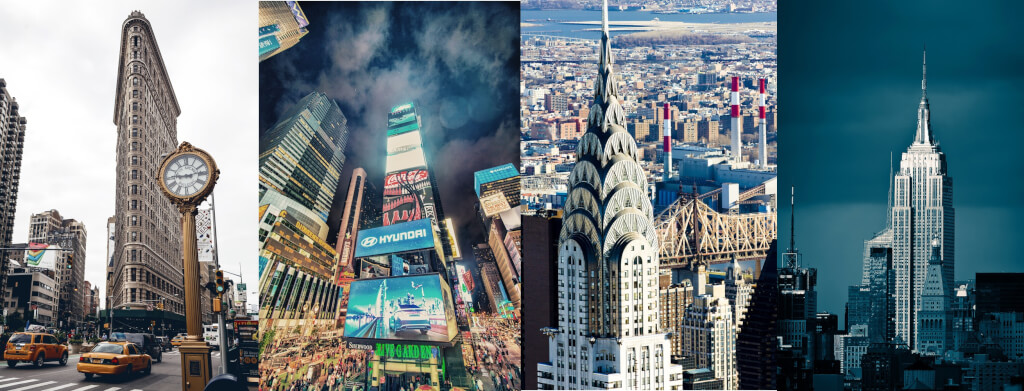
From left to right: Flatiron Building, One Times Square, Chrysler Building, Empire State Building. Photo: Vector, ForumDaily collage
But the most famous New York skyscrapers could. The oldest of them, the Flatiron Building, 87 meters high, was erected back in 1902. It is located on the very corner, at the junction of Broadway, Fifth Avenue and East 23rd Street. Due to its unusual shape, it received the name “iron” and was included in the list of objects of National Historic Monuments.
No less famous is the One Times Square skyscraper, 120 meters high, built in 1904 year, as the new headquarters of the New York Times. Located at the intersection of Broadway and 42 Street, it is widely known to both residents of the city and its guests, thanks to the New Year's tradition of "dropping the crystal ball." Every year on 1907, on 23: 59, this illuminated ball begins to slide down from the 23-meter height over the flagpole of the building, symbolizing the beginning of the new year. After moving the newspaper to another place, this building is traditionally used for advertising purposes, and is hung from top to bottom with electronic advertisements, which are so common for regular visitors to Broadway.
The Chrysler Building, a Chrysler Corporation skyscraper built in 1930, is another recognized symbol of New York. The building, 320 meters high, ends with a peculiar tower, the ornamentation of which repeats the design motifs of the caps on the wheel rims of Chrysler cars of that time. It is one of the finest examples of the Art Deco period in New York architecture, the most beautiful period in its development.
And, of course, the Empire State Building is a 103-story skyscraper, built in 1931, in the Art Deco style, and has a height of 443,2 meters. One of the most visited tourist sites in New York (especially its observation deck on the 86th and 102nd floors), it is currently the third tallest skyscraper in the United States, behind the Freedom Tower in New York and the Willis Tower in Chicago. It was included in the list of National Historic Landmarks of the United States, and number one in the list of the best architectural achievements of the country according to the American Institute of Architects.
Unfortunately, these best examples of New York architecture have already celebrated, or are soon about to celebrate, their centenary history. And looking at the post-war development of the city center, which was dull or made with a pretense of originality, one gets the impression that its architects froze somewhere in those distant times when “thin and long” shone on the podium, forgetting that their place had long been taken by beautiful , natural and pleasant. And if “the new is the well-forgotten old,” then here they are, these examples - before their eyes. And it’s wonderful that a new generation of architects is already emerging who understand this and are able to pick up the baton, naturally taking into account new technologies and materials, modern ideas and trends.
In 1962, nine of the ten skyscrapers ranked among the tallest buildings in the world were located in Manhattan. In 1981, the situation changed slightly: five of the tallest towers stretched to the sky in Manhattan, but together with three Chicago skyscrapers, they still made up eight of the ten tallest skyscrapers in the world. Today, there is only one skyscraper in the USA, one of the ten tallest buildings in the world. This is One World Trade Center, built on the site of the destroyed “twins”.
He said that when it comes to the conceptualization of skyscrapers in urban development on the planet, New York continues to be one of the leaders.
Despite the fact that from the data provided by the Newgeograph resource and the Skuscraper Center website, it is clear that the majority of buildings with a height of more than 150 meters are now predominantly located in East Asia (7 out of 10 and 18 out of 25 tallest). Hong Kong ranks first in the ranking of cities with the largest number of high-rise buildings. In total, there are 317 skyscrapers, and only one of them, the International Commercial Center, is included in the list of the tallest buildings in the world. It is followed by New York with 257 skyscrapers. At the same time, its tallest building, One World Trade Center, ranks sixth among the tallest buildings in the world. It is followed in the top ten cities with the highest concentration of skyscrapers by Dubai, Tokyo, Shanghai, Shenzhen, and then Chicago, Chongqing, Guangzhou and Singapore.
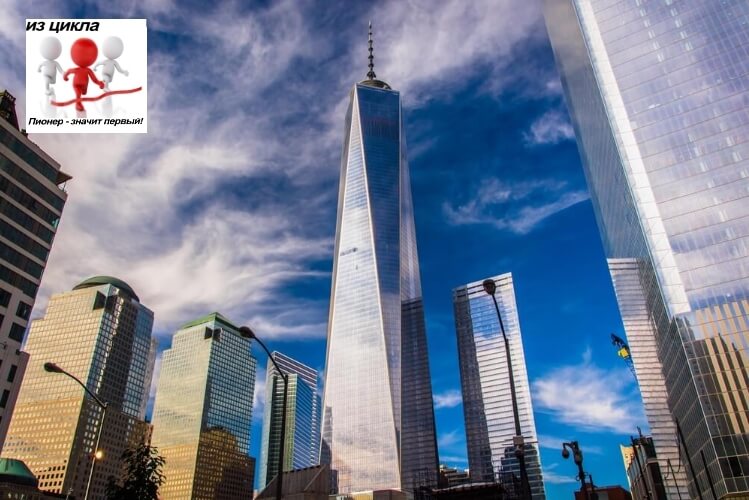
Фото: Depositphotos
This is how the emphasis in the world is now shifting. Because the psychology of skyscraper construction has fundamentally changed. New materials and other technical capabilities have appeared, and the search for optimal architectural forms has expanded. However, the world still remembers the date - 1885 and the world's first skyscraper - the Home Insurance Building - erected in Chicago. And its author is the engineer and architect William Le Baron Jenney, who rightfully bears the name of the “father of skyscrapers.” At the Chicago School of Architecture, he was known as the patriarch, being older and more experienced than many of them. And when in 1998, out of thousands of applicants, the Man of the Millennium was chosen in America, he not only made it onto the list of applicants, but also took a worthy 89th place in it. Because thanks to the efforts of William Jenney and his colleagues, the era of skyscrapers began, and America became their homeland. They were pioneers in the design and construction of skyscrapers, and are rightfully proud of being the first.
But today we are well aware that their main achievement lies in a slightly different plane. Yes, America is gradually giving way to the leading position in the number of skyscrapers erected, their height and the duration of construction. But after all, all these world achievements became possible only because more than a century ago, with the submission of specialists from the Chicago School, it was in America that the architects managed to create a completely new aesthetics of perception of the urban environment. Thanks to them, the main architectural dominant of the city was not the temple, which was installed on the highest point of the city (as was the custom for many centuries), but a conglomerate of various and different-sized skyscrapers, the silhouettes of which allowed to make the cities of the world so unusual and memorable, surrounded by peculiar and unique aura, making them so attractive to the whole world. Skyline is not only a new century, but also a “New World”.
Read also on ForumDaily:
Statue of Liberty: the history of the American symbol
Golden Gate Bridge: the history of the American symbol
Bourbon: the history of the American symbol
Flag: the history of the American symbol
Bison: The History of the American Symbol
Rose: the history of the American symbol
Oak, Sequoia and Christmas Tree: The History of the American Symbol
Bald Eagle and the United States Great Seal (Coat of Arms): The History of the American Symbol
From Colombia to Uncle Sam: The History of the American Symbol
The White House: The History of the American Symbol
Dollar: the history of the American symbol
Apple Pie: The History of the American Symbol
Hot Dog: The History of the American Symbol
Subscribe to ForumDaily on Google NewsDo you want more important and interesting news about life in the USA and immigration to America? — support us donate! Also subscribe to our page Facebook. Select the “Priority in display” option and read us first. Also, don't forget to subscribe to our РєР ° РЅР ° Р »РІ Telegram and Instagram- there is a lot of interesting things there. And join thousands of readers ForumDaily New York — there you will find a lot of interesting and positive information about life in the metropolis.












